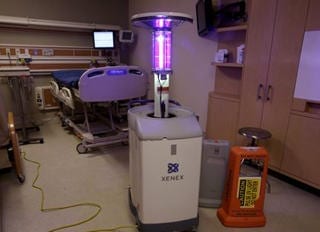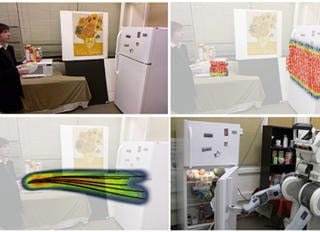
“Smart” paper developed at NDSU
Dr. Val Marinov’s team has developed a method to embed ultra-thin, ultra-small RFID chips on paper or other flexible substrates, which could lead to ways to reduce counterfeiting of a wide variety of items such as pharmaceuticals, currency, legal papers, bearer bonds and other security documents. The patent-pending process, known as Laser Enabled Advanced Packaging, uses a laser beam’s energy to precisely transfer and assemble chips with dimensions well below those possible using conventional methods.
The embedding method involves chips thinner than most commercial RFID chips on the market today. “We use our LEAP technology to embed ultra-thin, ultra-small semiconductor chips, including 350 µm/side, 20 µm thick semiconductor dice, in paper substrates with a thickness of <120 µm,” said Dr. Marinov, associate professor of industrial and manufacturing engineering at NDSU.
RFID-enabled paper could be used to reduce counterfeiting and to improve the tracking of paper documents of all kinds, according to Dr. Marinov. In addition, this method could enable the production of paper-based RFID tags at a cost lower than that of today’s conventional RFID tags and at packaging rates multiple times higher than those attainable with the conventional pick-and-place technology. The research has been featured in RFID Journal, as well as in scientific publications.
Antennaless RFID tags developed at NDSU
As part of the IEEE International Conference on RFID, Bauer-Reich will discuss research at NDSU’s Center for Nanoscale Science and Engineering to develop on-metal RFID tags that use the structure of the tagged object as the antenna. This research has been featured in publications such as RFID Journal, R&D Magazine and Gizmag. Her talk is part of a workshop on Enhancing Near-Metal Performance of RFID.
UHF RFID Antenna for Wireless Sensor Platform
Layne Berge, a graduate student in Electrical and Computer Engineering at NDSU, is presenting a paper titled “A UHF RFID Antenna for a Wireless Sensor Platform with a Near-Isotropic Radiation Pattern,” as part of the IEEE conference.
The paper was co-written with Dr. Michael Reich, senior research engineer at NDSU CNSE. The research focuses on developing spherical sensor platforms that can communicate using RFID protocols, regardless of orientation. This is useful for sensors that cannot be deployed with a guaranteed orientation, such as those dropped from aircraft.
The Latest Bing News on:
Radio frequency identification
- Sen. Rounds bill would prevent mandatory electronic tags for cattle and bisonon May 10, 2024 at 9:58 am
The rule requires official ear tags to be visually and electronically readable for interstate movement of certain cattle and bison ...
- Radio Frequency Identificationon May 9, 2024 at 7:45 am
Any method of identifying unique items using radio waves. Typically, a reader (also called an interrogator) communicates with a transponder, which holds digital information in a microchip. But there ...
- Global RFID Blood Monitoring Systems Market Set to Flourish, Anticipated to surge to USD 218.4 Million by 2032on May 8, 2024 at 10:41 pm
The global RFID blood monitoring systems market is poised to experience significant growth, according to a recent market analysis. Forecasted to achieve a remarkable Compound Annual Growth Rate (CAGR) ...
- Automatic Identification And Data Capture Market Size To Hit USD 133.31 Billion, Growing At A CAGR Of 12.1% By 2030on May 5, 2024 at 5:55 am
( MENAFN - Evertise Digital) - The Automatic Identification and Data Capture Market size was valued at USD 53.46 billion in 2022 and is expected to grow to USD 133.31 billion by 2030 and grow at a ...
- Southern Utah ranchers express frustration over USDA's electronic tag mandateon May 4, 2024 at 7:06 am
Southern Utah's ranchers are grappling with frustration over a recent U.S. Department of Agriculture mandate. The rule states that all sexually intact cattle and bison transported across state lines ...
- Federal Circuit Revives Patent Suit Axed for Lack of Standingon May 1, 2024 at 11:52 am
A Texas owner of a radio frequency identification patent has constitutional standing to sue a maker of RFID products, despite arguments that it lost standing due to a loan agreement, the Federal ...
- Radio Frequency Identification (RFID): What It Is, How It Workson April 23, 2024 at 12:29 pm
Radio Frequency Identification (RFID) is a technology that uses radio waves to passively identify a tagged object. It is used in several commercial and industrial applications, from tracking items ...
- Radio Frequency Identification Engineeringon April 13, 2024 at 3:34 pm
To save content items to your account, please confirm that you agree to abide by our usage policies. If this is the first time you use this feature, you will be asked to authorise Cambridge Core to ...
- Radio Frequency Identification Engineeringon April 13, 2024 at 3:33 pm
Radio frequency identification (RFID) is an undeniable aspect of modern living, being used from logistics, access control and banking to smart cities, smart transportation and as a key enabler of the ...
- Radio Frequency Identification (RFID) Tagson December 2, 2022 at 4:01 am
Radio Frequency Identification (RFID) tags are small electronic devices which use radio signals to send messages and can have a variety of uses including vehicle tracking, pet and livestock tracking, ...
The Latest Google Headlines on:
Radio frequency identification
[google_news title=”” keyword=”radio frequency identification” num_posts=”10″ blurb_length=”0″ show_thumb=”left”]
The Latest Bing News on:
Counterfeiting
- Protecting Your Brand: Strategies for Trademark Enforcement in Germanyon May 12, 2024 at 4:03 pm
Protecting trademarks in Germany demands a comprehensive approach, integrating legal action, technology, consumer education, and global ...
- Use of Fake Money Reported Across US After Secret Service Seizes $21,800,000 of Counterfeit Cash in One Yearon May 12, 2024 at 9:06 am
Reports of people trying to use counterfeit cash are spreading across the US. Headlines on various attempts to pay with fake money are popping up across the country, with ABC News declaring ...
- The Ultimate Shield: The Best Possible Protection against Counterfeiting and Piracyon May 12, 2024 at 2:18 am
In an era where globalization and technological advancements have facilitated the proliferation of counterfeit goods, businesses face an ever-increasing threat of brand piracy. Counterfeiting and ...
- Novo Nordisk’s Fight Against Ozempic Counterfeitson May 11, 2024 at 4:45 am
Investigations by the pharmaceutical giant into the proliferation of fake versions of its medicine highlight how drugmakers can be proactive, collaborate with authorities on tackling counterfeiting.
- Dischinger Orthodontics Embroiled in $28 Million Lawsuit Over Use of Off-Brand Invisalignon May 9, 2024 at 11:46 am
A Lake Oswego orthodontist is in the crosshairs of a $20 billion medical device company, Align Technologies, which alleged in a federal lawsuit filed on Tuesday that Dischinger Orthodontics is ...
- Convicted murderer was last person to see woman missing from Dauphin Countyon May 8, 2024 at 10:01 pm
Online court records show he is being held at the Dauphin County Prison on a combined $250,000 bail on theft, counterfeiting and drug possession charges. ‘Heading to Harrisburg’ On Feb. 7, Proctor ...
- ASPA webinar on combating counterfeiting in pharm industryon May 7, 2024 at 11:29 pm
To bolster its message, ASPA will host an online webinar titled, PharmaGuard: Navigating Counterfeiting Challenges in the Pharmaceutical Supply Chain on 17 May. This webinar promises to offer valuable ...
- Former West Lafayette police officer charged with official misconduct, counterfeitingon April 30, 2024 at 5:02 pm
Special Prosecutor Rodney Cummings charged Forgey with felony counts of official misconduct and counterfeiting. Forgey is accused of faking a warrant to get into a fraternity house in November 2023.
- Anti-counterfeiting notch at 9 o’clock on gold American Eagleon April 30, 2024 at 5:01 am
W American Eagle 1-ounce .9167 fine gold $50 coin is expected for release this summer, and its anti-counterfeiting notch will be found at the fourth location used since the device was instituted.
- Special prosecutor charges WLPD officer with counterfeiting, official misconducton April 29, 2024 at 9:09 am
A special prosecutor is charging a former West Lafayette police officer who resigned earlier this year after his alleged pattern of misconduct came to light.
The Latest Google Headlines on:
Counterfeiting
[google_news title=”” keyword=”counterfeiting” num_posts=”10″ blurb_length=”0″ show_thumb=”left”]










